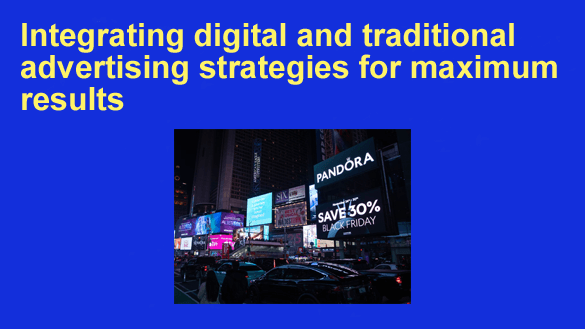 Adopting multiple strategies in today’s fast-paced advertising landscape is critical to crafting comprehensive and impactful marketing campaigns. Digital platforms continue to dominate advertising strategies, so digital billboard ads have proven especially powerful at drawing in customers while driving brand visibility.
Adopting multiple strategies in today’s fast-paced advertising landscape is critical to crafting comprehensive and impactful marketing campaigns. Digital platforms continue to dominate advertising strategies, so digital billboard ads have proven especially powerful at drawing in customers while driving brand visibility.
Yet while digital ads offer flexibility and dynamic effects, traditional methods still retain considerable worth – businesses that combine both approaches can take advantage of each’s advantages to craft an integrated advertising approach that maximizes reach and effectiveness.
The role of digital billboard ads in modern advertising
Digital billboard ads have profoundly transformed the outdoor advertising landscape, providing more flexibility and dynamic interaction compared to static billboards.
Digital billboards featuring advanced LED technology offer users a range of content – from static images and animated graphics, which can be changed instantly in real-time – that are updated in real-time for maximum effectiveness in high-traffic areas where immediate eyeball capture is key.
This functionality makes these billboards particularly beneficial. Digital billboards’ ability to adjust content according to factors like time of day, audience demographics, or even weather conditions makes them highly responsive and relevant – an indispensable resource in contemporary advertising strategies.
Digital billboard ads feature interactive elements designed to capture viewers quickly. By incorporating real-time data, digital billboard ads are capable of providing tailored messages that resonate more deeply with target audiences – not only is this eye-catching but it encourages interaction as well!
Adding another key benefit of these advertisements, their dynamic nature enables advertisers to experiment with creative approaches or message variations depending on viewer performance metrics or viewer feedback – this creates memorable advertising experiences!
Benefits of traditional advertising methods
While digital billboard ads provide many advantages, traditional methods still play a vital part in an effective marketing plan. Print ads, radio spots, and static billboards remain effective ways of reaching audiences and building brand recognition with specific demographics who might otherwise not engage as closely with digital platforms such as billboard ads or billboard ads.
For example, static billboards placed strategically can reinforce brand messages and raise their visibility among commuters and pedestrians; print ads in local newspapers or magazines may reach specific communities; radio advertisements provide auditory engagement that may capture drivers during their commute; combined with these traditional strategies can form the basis of an extensive and efficient advertising campaign.
Integrating digital and traditional advertising strategies
Combining digital billboard ads with traditional methods provides many advantages. Leveraging their strengths to craft an integrated campaign that maximizes reach and impact; for instance, using dynamic content can complement static billboards’ long-term message reinforcement capabilities.
Planning an integrated campaign takes into account how digital billboard ads could enhance traditional advertisements by using strategic placement to enhance their effectiveness.
For example, pairing one digital billboard campaign with another print ad campaign would ensure multiple touchpoints for audiences with your message; creating multiple touch points across different mediums to ensure effective delivery and longevity for messages across mediums.
Tips for successful integration
To effectively combine digital and traditional advertising strategies, follow these tips:
1 – Consistent Messaging: Aimed at reinforcing brand identity while optimizing campaign results.
2 – Targeted Placement: Select locations for both digital and traditional ads that reflect their target audiences based on how you intend to reach them most efficiently, whether that means high-traffic areas for digital billboards or community placement of print ads.
3 – Budget Allocation: When allocating your budget, think carefully about its distribution based on factors like reach, frequency, and audience engagement when planning it.
4 – Performance Tracking: Monitor both digital and traditional ads to evaluate their efficacy, using data insights to adjust and enhance your strategy for optimal campaign results.
5 – Creative Synergy: Make sure that the creative assets created for use across platforms work cohesively – this means high-quality visuals, captivating content, and clear calls-to-action must all feature on both digital and traditional ads.
Conclusion
Integrating both digital and traditional advertising strategies can enhance the success of marketing campaigns dramatically.
By understanding both their unique benefits, such as digital billboard ads, as well as those offered by traditional methods like billboard placement or media buys, you can combine them into an approach that maximizes reach and engagement – with strategic billboard placement playing an invaluable part in your integrated campaign. Consider adopting both forms to drive better results towards reaching marketing goals more successfully.